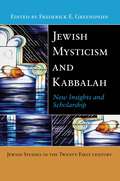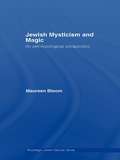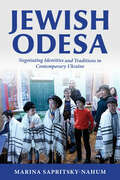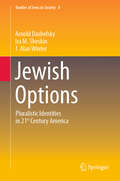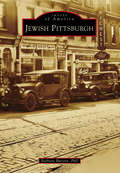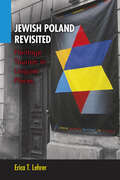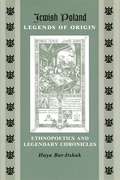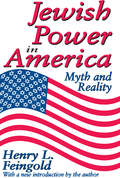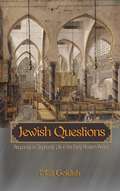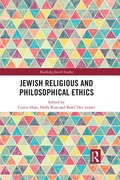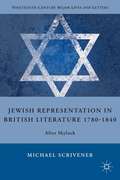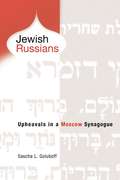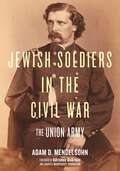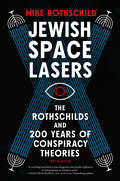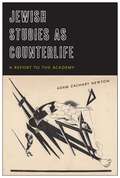- Table View
- List View
Jewish Mysticism and Kabbalah: New Insights and Scholarship (Jewish Studies in the 21st Century #2)
by Frederick E GreenspahnInformative and accessible essays exploring contemporary scholarship in Jewish mysticism and Kabbalah.“This carefully edited collection of essays on Jewish mysticism effectively delivers on its promise to be accessible to broad audiences. The volume amounts to a thoughtful and lucid conversation among leading scholars. . . . The literate lay reader as well as faculty and students in a wide range of university courses will find this to be a most useful gateway to Jewish mysticism as well as an illumining account of current trends in scholarship.” —Jeremy Zwelling, Wesleyan UniversityOver the past generation, scholars have devoted increasing attention to the diverse forms that Jewish mysticism has taken both in the past and today: what was once called “nonsense” by Jewish scholars has generated important research and attention both within the academy and beyond, as demonstrated by the popular fascination with figures such as Madonna and Demi Moore and the growing interest in spirituality.In Jewish Mysticism and Kabbalah, leading experts introduce the history of this scholarship as well as the most recent insights and debates that currently animate the field in a way that is accessible to a broad audience. From mystical outpourings in ancient Palestine to the Kabbalah Centre, and from attitudes towards gender to mystical contributions to Jewish messianic movements, this volume explores the various expressions of Jewish mysticism from antiquity to the present day in an engaging style appropriate for students and non-specialists alike.“Refreshingly summarizes much of the current thinking about mysticism in general and Kabbalah in particular. The essays are thoughtful, provocative, and frequently even inspiring.” —Lawrence Kushner, author of I’m God, You’re Not“This is an excellent book for general readers who wish to learn about this fascinating area of Jewish life and literature, as the jargon of scholar-speak is kept to a minimum.” —Jewish Book Council
Jewish Mysticism and Magic: An Anthropological Perspective (Routledge Jewish Studies Series)
by Maureen BloomProviding a unique anthropological perspective on Jewish mysticism and magic, this book is a study of Jewish rites and rituals and how the analysis of early literature provides the roots for understanding religious practices. It includes analysis on the importance of sacrifice, amulets, and names, and their underlying cultural constructs and the persistence of their symbolic significance.
Jewish Odesa: Negotiating Identities and Traditions in Contemporary Ukraine (The Modern Jewish Experience)
by Marina Sapritsky-NahumJewish Odesa: Negotiating Identities and Traditions in Contemporary Ukraine explores the rich Jewish history in Ukraine's port city of Odesa. Long considered both a uniquely cosmopolitan and Jewish place, Odesa's Jewish character has shifted since the Soviet Union collapsed and Ukraine gained its independence.Drawing on extensive field research, Marina Sapritsky-Nahum examines how the role of Russian language and culture, memories of the Soviet political project, and Odesan's place in a Ukrainian national project have all been questioned in recent years.Jewish Odesa reveals how a city once famous for its progressive Jewish traditions has become dominated by Orthodox Judaism and framed by the agendas of international Jewish organizations embedded in a religiosity that is foreign to the city. Russia's war in Ukraine has forced Jewish identities with ties to Odesa to change still further.
Jewish Options: Pluralistic Identities in 21st Century America (Studies of Jews in Society #8)
by Arnold Dashefsky Ira M. Sheskin J.Alan WinterThis book offers an examination of an expanding set of options for being Jewish in contemporary American society. It examines the evolution of Jewish identity across five epochs of Jewish civilization as well as the transformation of the American Jewish experience across four centuries. In addition, an institutional history and a geographic, demographic, and religious profile of American Jews are presented, including an outline of contemporary Jewish options to express Jewish identity in twenty-first century America. Readers will gain an understanding of how these options developed via the provision of a socio-historical and a social scientific analysis of each option in one integrated volume. The book also discusses contemporary challenges to the continuity of American Jewish community and identity including the issues of education, interfaith marriage, and philanthropy.
Jewish Peoplehood
by Noam PiankoAlthough fewer American Jews today describe themselves as religious, they overwhelmingly report a strong sense of belonging to the Jewish people. Indeed, Jewish peoplehood has eclipsed religion--as well as ethnicity and nationality--as the essence of what binds Jews around the globe to one another. In Jewish Peoplehood, Noam Pianko highlights the current significance and future relevance of "peoplehood" by tracing the rise, transformation, and return of this novel term. The book tells the surprising story of peoplehood. Though it evokes a sense of timelessness, the term actually emerged in the United States in the 1930s, where it was introduced by American Jewish leaders, most notably Rabbi Stephen Wise and Rabbi Mordecai Kaplan, with close ties to the Zionist movement. It engendered a sense of unity that transcended religious differences, cultural practices, geographic distance, economic disparity, and political divides, fostering solidarity with other Jews facing common existential threats, including the Holocaust, and establishing a closer connection to the Jewish homeland. But today, Pianko points out, as globalization erodes the dominance of nationalism in shaping collective identity, Jewish peoplehood risks becoming an outdated paradigm. He explains why popular models of peoplehood fail to address emerging conceptions of ethnicity, nationalism, and race, and he concludes with a much-needed roadmap for a radical reconfiguration of Jewish collectivity in an increasingly global era. Innovative and provocative, Jewish Peoplehood provides fascinating insight into a term that assumes an increasingly important position at the heart of American Jewish and Israeli life.
Jewish Perspectives on Theology and the Human Experience of Disability
by Judith Z. Abrams William C. GaventaFew people are untouched by the issue of disability, whether personally or through a friend or relative. Jewish Perspectives on Theology and the Human Experience of Disability shares moving insights from around the world and across the broad spectrum of Judaism on how and why the Jewish community is incomplete without the presence and participation of the disabled. Authors representing each of the three main movements of Judaism--Orthodox, Conservative, and Reform--examine theology, scripture, ethics, practical theology, religious education, and personal experience to understand and apply the lessons and wisdom of the past to issues of the present.
Jewish Pittsburgh (Images of America)
by Barbara BurstinBy the mid-19th century, Jews from German lands began settling in Pittsburgh, later to be followed by Jews from the Russian and Austro-Hungarian Empires and Romania. They founded businesses and organizations such as Giant Eagle, Kaufmann's Department Store, Montefiore Hospital, the Pittsburgh Playhouse, the Civic Light Opera, and the Pittsburgh Pirates. Sophie Masloff became the first woman and the first Jew to serve as mayor, and civic reformer and lawyer A. Leo Weil, philanthropist Leon Falk Jr., and social justice crusader Florence Reizenstein all had schools named after them. From Allegheny City and "the Hill" to Squirrel Hill and the East End, the Jewish population preserved its distinct core community and contributed to its adopted city in multiple ways. Today, it numbers more than 40,000, and their story is one of grit, determination, risk taking, hard knocks, and no small measure of success.
Jewish Poland Revisited: Heritage Tourism In Unquiet Places (New Anthropologies of Europe)
by Erica T. LehrerSince the end of Communism, Jews from around the world have visited Poland to tour Holocaust-related sites. A few venture further, seeking to learn about their own Polish roots and connect with contemporary Poles. For their part, a growing number of Poles are fascinated by all things Jewish. Erica T. Lehrer explores the intersection of Polish and Jewish memory projects in the historically Jewish neighborhood of Kazimierz in Krakow. Her own journey becomes part of the story as she demonstrates that Jews and Poles use spaces, institutions, interpersonal exchanges, and cultural representations to make sense of their historical inheritances.
Jewish Poland—Legends of Origin: Ethnopoetics and Legendary Chronicles (Raphael Patai Series in Jewish Folklore and Anthropology)
by Haya Bar-ItzhakThe first appearance of Jews in Poland and their adventures during their early years of settlement in the country are concealed in undocumented shadows of history. What survived are legends of origin that early chroniclers, historians, writers, and folklore scholars transcribed, thus contributing to their preservation. According to the legendary chronicles Jews resided in Poland for a millennium and developed a vibrant community. <P><P> Haya Bar-Itzhak examines the legends of origin of the Jews of Poland and discloses how the community creates its own chronicle, how it structures and consolidates its identity through stories about its founding, and how this identity varies from age to age. Bar-Itzhak also examines what happened to these legends after the extermination of Polish Jewry during the Holocaust, when the human space they describe no longer exists except in memory. For the Polish Jews after the Holocaust, the legends of origin undergo a fascinating transformation into legends of destruction. <P><P> Jewish Poland-Legends of Origin brings to light the more obscure legends of origin as well as those already well known. This book will be of interest to scholars in folklore studies as well as to scholars of Judaic history and culture.
Jewish Population and Identity: Concept and Reality (Studies of Jews in Society #1)
by Uzi Rebhun Sergio DellaPergolaThis book examines the fundamentals of Jewish demography and sociology around the world. It is not only concerned with documenting patterns of population change but also with an intriguing and ever-present issue like "Who is a Jew?" The latter transcends the limits of quantitative assessment and deeply delves into the nature, boundaries, and quality of group identification. A growing challenge is how to bridge between concept – related to ideals and theory – and reality – reflecting field research. Divided into six sections, the book discusses historical demography, immigration and settlement, population dynamics, social stratification and economy, family and Jewish identity in the U.S., and Jewish identity in Israel. The volume represents the dynamic and diverse nature of the study of world and local Jewish populations. It shows how that field of study provides an important contribution to the broader and now rapidly expanding study of religious and ethnic groups. Scholars in disciplines such as history, geography, sociology, economics, political science, and especially demography follow and analyze the social and cultural patterns of Jews in different places around the globe, at various times, and from complementary perspectives. They make use of historical sources that have recently become accessible, utilize new censuses and surveys, and adopt advanced analytical methods. While some of their observations attest to consistency in the Jews’ demographic and identificational patterns, others evolve and ramify in new directions that reflect general processes in the areas and societies that Jews inhabit, internal changes within Jewish communities, and intergenerational trends in personal preferences of religious and ethnic orientations. This volume brings together contributions from scholars around the world and presents new and updated research and insights.
Jewish Power in America: Myth and Reality
by Henry FeingoldJewish political power exists as a separate agency in the American polity, but before it can be determined whether it is inordinate, historian Henry L. Feingold declares that it first needs to be identified and defined. Jewish power is not associated with military armaments as with a sovereign state like Israel. Nor is it personal power. There are many influential Jews today who have raised huge sums for office seekers, but there are none whose use of financial resources was inordinate. With the exception of an abiding concern with the security of Israel, there are no overriding public policy concerns that differentiate Jewish voters from the informed, educated segment of the American electorate.Feingold acknowledges that American Jews do have political power. But what kind is it, and how does it compare to the power exercised by other ethnic and interest groups that thrive in the American polity? The basic charge of those who have raised the alarm about Jewish power—that it is used conspiratorially against the national interest—is addressed and repudiated. This book addresses the question of Jewish power by examining five recent major instances, beginning with the New Deal, when the play of Jewish power, or power exercised by Jews, was evident.The engagement of American Jewry in the political process is amply documented by survey research and evidenced by the disproportionate number of Jewish office holders on all levels of government. It can be traced in some measure to its relationship to European Jewish migration and to the inherent activism of the political left. The work presents the reader with a broadly comprehensive and highly informative picture of American Jewish participation in the American polity.
Jewish Pride
by Michael SteinhardtMichael Steinhardt left a stellar career on Wall Street and spent the next three decades launching revolutionary philanthropic programs like Birthright Israel and OneTable that offer a proud, rich future for the next generation of secular American Jews.What are the keys to a proud Jewish life? Part memoir, part manifesto, Michael Steinhardt&’s Jewish Pride offers a compelling vision for a rich, rewarding future for Jews in America and around the world. From his middle class beginnings in Brooklyn to a spectacular Wall Street career, Steinhardt understood that apathy and assimilation were threatening the Jewish future in America. Meanwhile established Jewish institutions were failing in the urgent task of strengthening secular Jewish identity. Using his own capital and the wisdom and connections he&’d gained in his successful business career, Steinhardt recruited partners, focused on data and results, and even got the Israeli government to help launch the revolutionary Birthright program. By turns provocative, inspiring, revealing, and outright hilarious, Jewish Pride captures its author&’s unique personality and outlook and offers honest talk about the Jewish world today, along with a bold prescription for revitalizing Jewish life in the future.
Jewish Questions: Responsa on Sephardic Life in the Early Modern Period
by Matt GoldishIn Jewish Questions, Matt Goldish introduces English readers to the history and culture of the Sephardic dispersion through an exploration of forty-three responsa--questions about Jewish law that Jews asked leading rabbis, and the rabbis' responses. The questions along with their rabbinical decisions examine all aspects of Jewish life, including business, family, religious issues, and relations between Jews and non-Jews. Taken together, the responsa constitute an extremely rich source of information about the everyday lives of Sephardic Jews. The book looks at questions asked between 1492--when the Jews were expelled from Spain--and 1750. Originating from all over the Sephardic world, the responsa discuss such diverse topics as the rules of conduct for Ottoman Jewish sea traders, the trials of an ex-husband accused of a robbery, and the rights of a sexually abused wife. Goldish provides a sizeable introduction to the history of the Sephardic diaspora and the nature of responsa literature, as well as a bibliography, historical background for each question, and short biographies of the rabbis involved. Including cases from well-known communities such as Venice, Istanbul, and Saloniki, and lesser-known Jewish enclaves such as Kastoria, Ragusa, and Nablus, Jewish Questions provides a sense of how Sephardic communities were organized, how Jews related to their neighbors, what problems threatened them and their families, and how they understood their relationship to God and the Jewish people.
Jewish Radical Feminism: Voices from the Women's Liberation Movement (Goldstein-Goren American Jewish History #3)
by Joyce AntlerFinalist, 2019 PROSE Award in Biography, given by the Association of American PublishersFifty years after the start of the women’s liberation movement, a book that at last illuminates the profound impact Jewishness and second-wave feminism had on each otherJewish women were undeniably instrumental in shaping the women’s liberation movement of the 1960s, 70s, and 80s. Yet historians and participants themselves have overlooked their contributions as Jews. This has left many vital questions unasked and unanswered—until now. Delving into archival sources and conducting extensive interviews with these fierce pioneers, Joyce Antler has at last broken the silence about the confluence of feminism and Jewish identity.Antler’s exhilarating new book features dozens of compelling biographical narratives that reveal the struggles and achievements of Jewish radical feminists in Chicago, New York and Boston, as well as those who participated in the later, self-consciously identified Jewish feminist movement that fought gender inequities in Jewish religious and secular life. Disproportionately represented in the movement, Jewish women’s liberationists helped to provide theories and models for radical action that were used throughout the United States and abroad. Their articles and books became classics of the movement and led to new initiatives in academia, politics, and grassroots organizing. Other Jewish-identified feminists brought the women’s movement to the Jewish mainstream and Jewish feminism to the Left. For many of these women, feminism in fact served as a “portal” into Judaism.Recovering this deeply hidden history, Jewish Radical Feminism places Jewish women’s activism at the center of feminist and Jewish narratives. The stories of over forty women’s liberationists and identified Jewish feminists—from Shulamith Firestone and Susan Brownmiller to Rabbis Laura Geller and Rebecca Alpert—illustrate how women’s liberation and Jewish feminism unfolded over the course of the lives of an extraordinary cohort of women, profoundly influencing the social, political, and religious revolutions of our era.
Jewish Religious and Philosophical Ethics (Routledge Jewish Studies Series)
by Halla Kim Curtis Hutt Berel Dov LernerTwentieth century continental thinkers such as Bergson, Levinas and Jonas have brought fresh and renewed attentions to Jewish ethics, yet it still remains fairly low profile in the Anglophone academic world. This collection of critical essays brings together the work of established and up-and-coming scholars from Israel, the United States, and around the world on the topic of Jewish religious and philosophical ethics. The chapters are broken into three main sections – Rabbinics, Philosophy, and Contemporary Challenges. The authors address, using a variety of research strategies, the work of both major and lesser-known figures in historical Jewish religious and philosophical traditions. The book discusses a wide variety of topics related to Jewish ethics, including "ethics and the Mishnah," "Afro Jewish ethics," "Jewish historiographical ethics," as well as the conceptual/philosophical foundations of the law and virtues in the work of Martin Buber, Hermann Cohen, and Baruch Spinoza.The volume closes with four contributions on present-day frontiers in Jewish ethics. As the first book to focus on the nature, scope and ramifications of the Jewish ethics at work in religious and philosophical contexts, this book will be of great interest to anyone studying Jewish Studies, Philosophy and Religion.
Jewish Representation in British Literature 1780–1840
by Michael ScrivenerDescribing Jewish representation bothby Jews and Gentiles in the British Romantic era, Scrivener integrates popular culture with belletristic writing to explore the wildly varying treatments of stereotypical figures: the pedlar, the moneylender, the Jew's daughter, "la belle juive," the convert, the prophet, the alchemist, and the criminal. "
Jewish Revival Inside Out: Remaking Jewishness in a Transnational Age (Raphael Patai Series in Jewish Folklore and Anthropology)
by Zvi Gitelman Shaul Magid Daniel Monterescu Michael Paley Jonathan Boyarin Geneviève Zubrzycki Ruth Ellen Gruber Asher Biemann Sara Zorandy Hannah Tzuberi Lucine Endelstein Nissim Leon Rachel Werczberger Shlomo Guzmen-Carmeli Cara Rock-SingerAgainst the gloomy forecast of "The Vanishing Diaspora", the end of the second millennium saw the global emergence of a dazzling array of Jewish cultural initiatives, institutional modalities, and individual practices. These "Jewish Revival" and "Jewish Renewal" projects are led by Jewish NGOs and philanthropic organizations, the Orthodox Teshuva (return to the fold) movement and its well-known emissary Chabad-Lubavitch Hasidism, and alternative cultural initiatives that promote what can be termed "lifestyle Judaism." This range between institutionalized revival movements and ephemeral event-driven projects circumscribes a diverse space of creative agency, which calls for a bottom-up empirical analysis of cultural creativity and the re-invention of Jewish tradition worldwide. Indeed, the trope of a "Jewish Renaissance" has become both a descriptive category of an increasingly popular and scholarly discourse across the globe, and a prescriptive model for social action. This volume explores the global transformations of contemporary Jewishness, which give renewed meaning to identity, tradition, and politics in our post secular world.
Jewish Russians: Upheavals in a Moscow Synagogue
by Sascha L. GoluboffThe prevalence of anti-Semitism in Russia is well known, but the issue of race within the Jewish community has rarely been discussed explicitly. Combining ethnography with archival research, Jewish Russians: Upheavals in a Moscow Synagogue documents the changing face of the historically dominant Russian Jewish community in the mid-1990s. Sascha Goluboff focuses on a Moscow synagogue, now comprising individuals from radically different cultures and backgrounds, as a nexus from which to explore issues of identity creation and negotiation. Following the rapid rise of this transnational congregation—headed by a Western rabbi and consisting of Jews from Georgia and the mountains of Azerbaijan and Dagestan, along with Bukharan Jews from Central Asia—she evaluates the process that created this diverse gathering and offers an intimate sense of individual interactions in the context of the synagogue's congregation.Challenging earlier research claims that Russian and Jewish identities are mutually exclusive, Goluboff illustrates how post-Soviet Jews use Russian and Jewish ethnic labels and racial categories to describe themselves. Jews at the synagogue were constantly engaged in often contradictory but always culturally meaningful processes of identity formation. Ambivalent about emerging class distinctions, Georgian, Russian, Mountain, and Bukharan Jews evaluated one another based on each group's supposed success or failure in the new market economy. Goluboff argues that post-Soviet Jewry is based on perceived racial, class, and ethnic differences as they emerge within discourses of belonging to the Jewish people and the new Russian nation.
Jewish San Francisco (Images of America)
by Edward Zerin Dr Marc DollingerIn San Francisco, the "instant city" of the gold rush days, Jews were pioneers among pioneers. Some came as immigrants directly from Europe, others as resettled adventurers from the East Coast, and still others as scions of southern Sephardic families. Out of this mixed multitude emerged a community with synagogues and institutions to care for the needy and the sick, along with a dignified social fabric. New immigrants following the Russian pogroms of 1883 were absorbed, and the ashen ruins from the 1906 earthquake were rebuilt. The city's cultural treasures and social needs were enriched, and the city's Jews were nurtured by civic commitments. Today's 70,000 San Francisco Jews, standing upon the shoulders of pioneering giants, continue to build and rebuild.
Jewish Self-Hate
by Theodor LessingThe diagnosis of Jewish self-hatred has become almost a commonplace in contemporary cultural and political debates, but the concept’s origins are not widely appreciated. In its modern form, it received its earliest and fullest expression in Theodor Lessing’s 1930 book Der jüdische Selbsthaß. Written on the eve of Hitler’s ascent to power, Lessing’s hotly contested work has been variously read as a defense of the Weimar Republic, a platform for anti-Weimar sentiments, an attack on psychoanalysis, an inspirational personal guide, and a Zionist broadside. This new edition makes a seminal text in Jewish thought accessible to English readers for the first time.
Jewish Soldiers in the Civil War: The Union Army
by Adam D. MendelsohnOffers an engaging account of the experiences of Jewish soldiers in the Union Army during the Civil WarWhat was it like to be a Jew in Lincoln’s armies? The Union army was as diverse as the embattled nation it sought to preserve, a unique mixture of ethnicities, religions, and identities. Almost one Union soldier in four was born abroad, and natives and newcomers fought side-by-side, sometimes uneasily. Yet though scholars have parsed the trials and triumphs of Irish, Germans, African Americans, and others in the Union ranks, they have remained largely silent on the everyday experiences of the largest non-Christian minority to have served.In ways visible and invisible to their fellow recruits and conscripts, the experience of Jews was distinct from that of other soldiers who served in Lincoln’s armies. Adam D. Mendelsohn draws for the first time upon the vast database of verified listings of Jewish soldiers serving in the Civil War collected by The Shapell Roster, as well as letters, diaries, and newspapers, to examine the collective experience of Jewish soldiers and to recover their voices and stories. The volume examines when and why they decided to enlist, explores their encounters with fellow soldiers, and describes their efforts to create community within the ranks. This monumental undertaking rewrites much of what we think we know about Jewish soldiers during the Civil War.
Jewish South Jersey (Images of America)
by Allen Meyers Leonard F. VernonInitial Jewish settlements in South Jersey emerged in the mid-19th century and offered a safe haven for people to re-create strong families and practice religion freely, without fear of government-sponsored violence. Looking for work, German Jews first migrated from their community in Philadelphia to Trenton, and then spread south to Wildwood. Although Jewish settlers were mainly known as merchants and shop owners, many towns also boast the development of the Jewish farmer. While agriculture would eventually be abandoned in favor of manufacturing, there were many extremely successful and historically significant Jewish farms that flourished in the south. Now, of course, people of the Hebrew faith are productive players in every walk of life. Jewish South Jersey touches on the many contributions made by Jewish people in the southern part of the Garden State.
Jewish Space Lasers: The Rothschilds and 200 Years of Conspiracy Theories
by Mike RothschildWith the current rise of antisemitism, this important book looks at how one Jewish family —the Rothschilds—became a lightning rod for the conspiracy theories of the last two centuries, and how those theories are still very much alive today. In 2018 Congresswoman Marjorie Taylor Greene took to social media to share her suspicions that the California wildfires were started by &‘space solar generators&’ which were funded by powerful, mysterious backers. Instantly, thousands of people rallied around her, blaming the fires on &“Jewish space lasers&” and, ultimately, the Rothschild family. For more than 200 years, the name "Rothschild" has been synonymous with two things: great wealth, and conspiracy theories about what they're "really doing" with it. Almost from the moment Mayer Amschel Rothschild and his sons emerged from the Jewish ghetto of Frankfurt to revolutionize the banking world, the Rothschild family has been the target of myths, hoaxes, bizarre accusations, and constant, virulent antisemitism. Over the years, they have been blamed for everything from the sinking of the Titanic, to causing the Great Depression, and even creating the COVID-19 pandemic. Jewish Space Lasers: The Rothschilds and 200 Years of Conspiracy Theories is a deeply researched dive into the history of the conspiracy industry around the Rothschild family - from the "pamphlet wars" of Paris in the 1840s to the dankest pits of the internet today. Journalist and conspiracy theory expert Mike Rothschild, who isn't related to the family, sorts out myth from reality to find the truth about these conspiracy theories and their spreaders. Who were the Rothschilds? Who are they today? Do they really own $500 trillion and every central bank, in addition to &“controlling the British money supply?&” Is any of this actually true? And why, even as their wealth and influence have waned, do they continue to drive conspiracies and hoaxes?
Jewish Studies as Counterlife: A Report to the Academy
by Adam Zachary NewtonThis book tells the story of a Jewish Studies that hasn’t fully happened—at least not yet. Newton asks what we mean when we say “Jewish Studies”—and when we imagine it not as mere amalgam but as a project. Jewish Studies offers a unique perspective from which to view the horizon of the academic humanities because, although it arrived belatedly, it has spanned a range of disciplinary locations and configurations, from an “origin story” in nineteenth-century historicism and philology, to the emancipatory politics of the Enlightenment, to the ethnicity-driven pluralism of the postwar decades, to more recent configurations within an interdisciplinary cultural studies. The conflicted allegiances with respect to traditions, disciplines, divisions, stakes, and stakeholders represent the structural and historical situation of the field, as it comes into contact with the humanities more broadly.At once a literary and philosophical thinker, Newton deploys a tableau of texts in concert with an ensemble of vivid, elastic tropes not only to theorize Jewish Studies but also to reimagine it as an agent of that potency Jacques Derrida calls “leverage”—a force multiplier for the field’s multiple possibilities. In refiguring a Jewish Studies to come, the book intervenes in a broader discourse about the challenge of professing disciplinary knowledges while promoting transit across their boundaries. Jewish Studies as Counterlife further amplifies Newton’s career-long articulation of the dialogic as the staging ground of ethical encounter.
Jewish Studies at the Crossroads of Anthropology and History: Authority, Diaspora, Tradition (Jewish Culture and Contexts)
by Marina Rustow Ra‘anan S. Boustan Oren KosanskyOver the past several decades, the field of Jewish studies has expanded to encompass an unprecedented range of research topics, historical periods, geographic regions, and analytical approaches. Yet there have been few systematic efforts to trace these developments, to consider their implications, and to generate new concepts appropriate to a more inclusive view of Jewish culture and society. Jewish Studies at the Crossroads of Anthropology and History brings together scholars in anthropology, history, religious studies, comparative literature, and other fields to chart new directions in Jewish studies across the disciplines.This groundbreaking volume explores forms of Jewish experience that span the period from antiquity to the present and encompass a wide range of textual, ritual, spatial, and visual materials. The essays give full consideration to non-written expressions of ritual performance, artistic production, spoken narrative, and social experience through which Jewish life emerges. More than simply contributing to an appreciation of Jewish diversity, the contributors devote their attention to three key concepts—authority, diaspora, and tradition—that have long been central to the study of Jews and Judaism. Moving beyond inherited approaches and conventional academic boundaries, the volume reconsiders these core concepts, reorienting our understanding of the dynamic relationships between text and practice, and continuity and change in Jewish contexts. More broadly, this volume furthers conversation across the disciplines by using Judaic studies to provoke inquiry into theoretical problems in a range of other areas.
